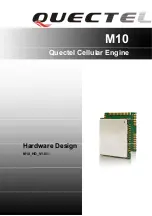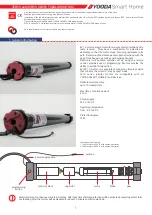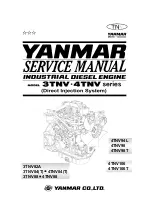
8
Engine Control Symbols and Meanings
Engine speed - FAST
Engine speed - SLOW
Engine speed - STOP
ON - OFF
Engine start - Choke
CLOSED
Engine start - Choke OPEN
Fuel Cap
Fuel Shut-off - OPEN
Fuel Shut-off - CLOSED
Fuel level - Maximum
Do not overfill
Assembly
Throttle Control Conversion
The standard engine has a manual throttle control. To operate with the manual throttle
control, to install a remote throttle control, or to convert to a fixed speed, follow the
appropriate instructions below.
Note:
After installation, the engine speed may need to be adjusted to meet the
equipment manufacturer's performance specifications. Contact a Briggs & Stratton
Authorized Service Dealer for assistance.
Manual Throttle Control
See Figure: 6
1.
Move the throttle control / TransportGuard® lever (A, Figure 6) to the OFF
position.
2.
Remove the spring (S, Figure 6).
Remote Throttle Control with Braided Wire Cable
A remote throttle control with a braided wire cable can be installed in either of two
directions;
Cylinder Head Direction
or
Front Direction
.
Cylinder Head Direction
See Figure: 4, 6
1.
Move the throttle control / TransportGuard® lever (A, Figure 4) to the FAST
position.
2.
Use a 10 mm wrench and loosen nut (P, Figure 6) ½ turn on the throttle control /
TransportGuard® lever (A).
3.
Hold the cable mounting nut (J, Figure 4) with a 10 mm wrench and loosen screw
(K).
4.
Install the cable wire (L, Figure 4) through the hole in the cable mounting nut (J)
and tighten screw (K). Make sure that the cable wire (L) does not extend more
than ½" (12,7 mm) past the hole.
5.
Loosen the screw (I, Figure 4). Secure the cable sleeve (N) under the cable
clamp (M) and tighten the screw (I).
6.
To check the operation of the remote throttle control, move the remote throttle
control from slow to fast a few times. The remote throttle control and the cable
wire (L, Figure 4) should move freely. Adjust nut (P, Figure 6) as needed for
desired operation.
Front Direction
See Figure: 5, 6
1.
Move the throttle control / TransportGuard® lever (A, Figure 5) to the FAST
position.
2.
Use a 10 mm wrench and loosen nut (P, Figure 6) ½ turn on the throttle control /
TransportGuard® lever (A).
3.
Hold the cable mounting nut (J, Figure 5) with a 10 mm wrench and loosen screw
(K).
4.
Install the cable wire (L, Figure 5) through the hole in the cable mounting nut (J)
and tighten screw (K). Make sure that the cable wire (L) does not extend more
than ½" (12,7 mm) past the hole.
5.
Loosen the screw (I, Figure 5). Secure the cable sleeve (N) under the cable
clamp (M) and tighten the screw (I).
6.
To check the operation of the remote throttle control, move the remote throttle
control from slow to fast a few times. The remote throttle control and the cable
wire (L, Figure 5) should move freely. Adjust nut (P, Figure 6) as needed for
desired operation.
Remote Throttle Control with Solid Wire Cable
A remote throttle control with a solid wire cable can be installed is any of four
directions;
Cylinder Head Direction, Front Direction, Left Direction,
or
Right
Direction
.
Cylinder Head Direction
See Figure: 6, 7
1.
Move the throttle control / TransportGuard® lever (A, Figure 6, 7) to the OFF
position.
2.
Remove the spring (S, Figure 6, 7).
3.
Move the throttle control / TransportGuard® lever (A, Figure 6, 7) to the FAST
position.
4.
Use a 10 mm wrench and loosen nut (P, Figure 6) ½ turn on the throttle control /
TransportGuard® lever (A).
5.
Install the Z-fitting of the solid wire cable (Q, Figure 7) to either one of the small
holes in the bellcrank (R).
6.
Loosen the screw (I, Figure 7). Secure the cable sleeve (N) under the cable
clamp (M) and tighten the screw (I).
7.
To check the operation of the remote throttle control, move the remote throttle
control from slow to fast a few times. The remote throttle control and the solid
wire cable (L, Figure 7) should move freely. Adjust nut (P, Figure 6) as needed
for desired operation.
Front Direction
See Figure: 6, 8
1.
Move the throttle control / TransportGuard® lever (A, Figure 6, 8) to the OFF
position.
2.
Remove the spring (S, Figure 6, 8).
3.
Move the throttle control / TransportGuard® lever (A, Figure 6, 8) to the FAST
position.
4.
Use a 10 mm wrench and loosen nut (P, Figure 6) ½ turn on the throttle control /
TransportGuard® lever (A).
5.
Install the Z-fitting of the solid wire cable (Q, Figure 8) to either one of the small
holes in the bellcrank (R).
6.
Loosen the screw (I, Figure 8). Secure the cable sleeve (N) under the cable
clamp (M) and tighten the screw (I).
7.
To check the operation of the remote throttle control, move the remote throttle
control from slow to fast a few times. The remote throttle control and the solid
wire cable (L, Figure 8) should move freely. Adjust nut (P, Figure 6) as needed
for desired operation.
Left Direction
See Figure: 6, 9
1.
Move the throttle control / TransportGuard® lever (A, Figure 9) to the OFF
position.
2.
Remove the spring (S, Figure 6).
3.
Move the throttle control / TransportGuard® lever (A, Figure 9) to the FAST
position.
4.
Use a 10 mm wrench and loosen nut (P, Figure 6) ½ turn on the throttle control /
TransportGuard® lever (A).
5.
Remove the throttle control knob (W, Figure 9) to expose the small hole (S).
6.
Install the Z-fitting of the solid wire cable (L, Figure 9) to the small hole (S) in the
throttle control lever (A).
7.
Loosen the screw (I, Figure 9). Secure the cable sleeve (N) under the cable
clamp (M) and tighten the screw (I).
8.
To check the operation of the remote throttle control, move the remote throttle
control from slow to fast a few times. The remote throttle control and the solid
wire cable (L, Figure 9) should move freely. Adjust nut (P, Figure 6) as needed
for desired operation.
Right Direction
See Figure: 6, 10
Not for
Reproduction
Summary of Contents for Vanguard 10V000
Page 2: ...2 VanguardPower com 1 2 3 4 5 N o t f o r R e p r o d u c t i o n...
Page 3: ...3 6 7 8 9 N o t f o r R e p r o d u c t i o n...
Page 4: ...4 VanguardPower com 10 11 12 13 14 15 16 17 18 19 N o t f o r R e p r o d u c t i o n...
Page 5: ...5 20 21 22 23 24 25 26 27 N o t f o r R e p r o d u c t i o n...









































